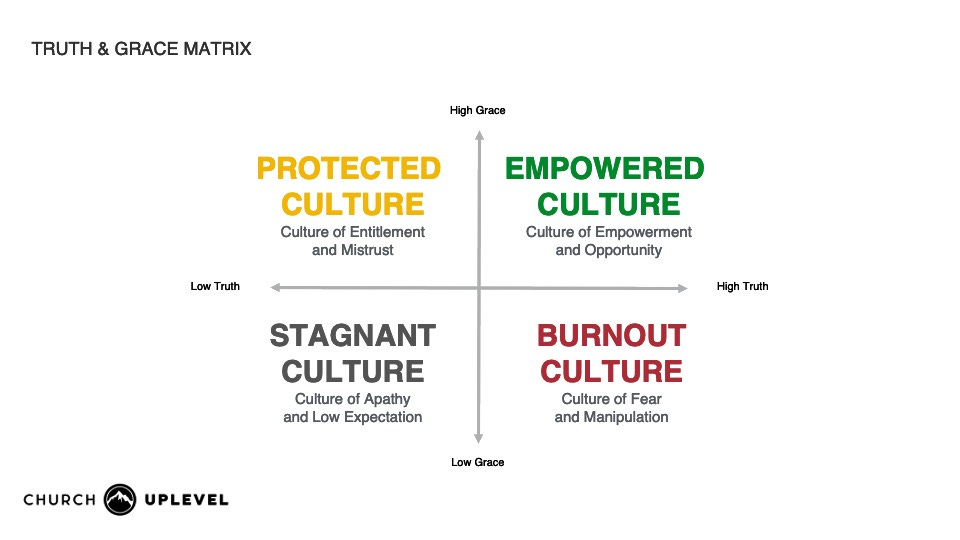In this episode of the Examined podcast, Jared explores the foundational concept of healthy leadership modeled by Jesus, focusing on balancing grace and truth. He introduces the 'Grace & Truth Matrix,' a tool to help leaders evaluate and improve their leadership styles across four potential cultures: burnout, entitled, stagnant, and empowered. Jared delves into the characteristics and impacts of each culture, offering practical advice for shifting towards an empowered leadership style where people are both supported and challenged to reach their highest potential.
00:00 Introduction to the Examined Community
00:48 The Importance of Grace and Truth in Leadership
04:12 Understanding the Grace and Truth Matrix
05:25 High Truth, Low Grace: The Burnout Culture
08:38 High Grace, Low Truth: The Entitled Culture
12:59 Low Grace, Low Truth: The Stagnant Culture
16:07 High Grace, High Truth: The Empowered Culture
20:17 Practical Steps to Empowered Leadership
22:58 Conclusion and Prayer
The Tension of Grace and Truth in Leadership
Every leader encounters a critical tension at some point in their journey, whether or not they can articulate it. Some leaders naturally lead with grace, offering deep empathy and support, but struggle with challenging others, avoiding conflict and confrontation. Conversely, others lead with truth, valuing honesty and high expectations, sometimes resulting in interactions that leave followers feeling diminished rather than empowered.
This imbalance crafts cultures that either suffocate potential with excessive grace or breed burnout with relentless truth.
In organizations where grace and truth are inadequately balanced, individuals question their purpose and struggle to see God’s presence in their leadership experiences.
The challenge, therefore, is to find equilibrium, a leadership model Jesus himself epitomized.
Unpacking the Grace and Truth Matrix
Referencing the scriptures, particularly the Book of John, we learn that Jesus was a living embodiment of grace and truth, fully present in both aspects. True leadership requires us to adopt a similar wholeness, fully embracing both grace and truth, consistently and without compromise.
Exploring Different Leadership Cultures
The Grace and Truth Matrix outlines four distinct leadership cultures:
Burnout Culture (High Truth, Low Grace): Leadership that demands high performance without providing emotional or relational support, resulting in exhaustion and disconnection. This culture resonates with the Pharisees’ rigid standards without accompanying support, often seen in leaders who know their metrics but lack personal connection with their teams.
Entitled Culture (High Grace, Low Truth): While overflowing with patience and support, this culture lacks challenge and accountability, leading to stagnation and passivity. Often witnessed in organizations that fear losing people by raising standards, the result is an environment where comfort is mistaken for growth.
Stagnant Culture (Low Grace, Low Truth): Characterized by a lack of care and challenge, this culture breeds apathy and disengagement. It reflects leaders who, due to exhaustion, stop showing up emotionally, allowing a vacuum where disengagement festers.
Empowered Culture (High Grace, High Truth): This is the pinnacle of leadership cultures—what Jesus modeled. Here, individuals are nurtured and simultaneously challenged, encouraging growth beyond perceived limitations. Authentic feedback, steadfast support, and a call to a higher purpose define an empowered culture.
Embedding Empowered Leadership
To embrace an empowered leadership style, consider these steps:
Diagnose Your Default: Honestly assess whether your leadership is predominantly grace-filled or truth-oriented. This awareness sets the foundation for balanced leadership.
Speak Grace Where It’s Missing: Find individuals you’ve challenged and infuse encouragement into their experiences. Highlight their strengths and contributions alongside constructive feedback.
Speak Truth Where You’ve Been Quiet: Engage in candid conversations with those you’ve shielded from discomfort. Present feedback as a pathway to elevate their potential, demonstrating commitment to their growth.
In adopting these practices, you will foster environments ripe for transformative leadership, where individuals aspire not just to meet expectations but to exceed them.
Reflect on the impact your leadership has on those you guide. Are they thriving under empowerment, or floundering within burnout, entitlement, or stagnation?





